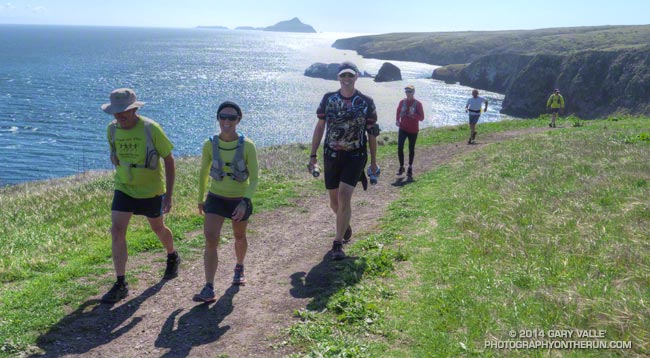
Great outing to Santa Cruz Island today as a guest of the Trail Runners Club.
Here are a few photos taken along the way.

Great outing to Santa Cruz Island today as a guest of the Trail Runners Club.
Here are a few photos taken along the way.
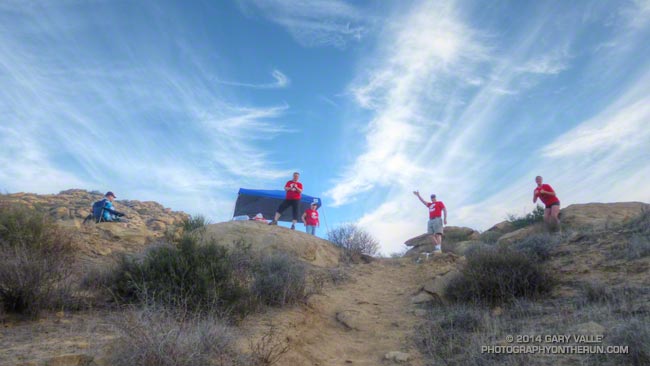
As I worked up the hill toward “Fossil Point” I drank the last mouthful of water from my bottle. I wasn’t surprised that I had run out. The morning temperature had been the warmest in the six year history of the event, and the midday temp in the sun felt like it was in the mid-80’s — maybe higher.
In Southern California it has been the kind of Winter that those in northern climes can only dream about: Day after day with fair skies and the temperature in the 70’s and 80’s. Great for trail running, but with the trade-off that we had had the least amount of rain in over a century.
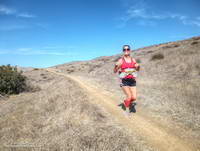
Chugging up the steep hill I thought about how the run had gone so far. Even if it was a little warm, it was still a pretty good day for a trail run! I hadn’t tried to push the pace on the initial steep climb from Corriganville, and had (mostly) resisted the temptation to pound down the Chumash Trail. The crazy-steep section of Hot Dog Hill on the out and back section of the course felt just as steep and insane as it did last year and the downhill to the Open Space aid station just as pleasant.
It was awe-inspiring to see the faster runners as they returned from Tapo Canyon. As I started the descent into Chivo Canyon Jay Bonthius, the eventual winner of the 50K, had flashed past. The youngest runner in the race, the 19 year old went on to finish his first 50K in 4:05:52 — setting a new course record. His average pace was a remarkable 7:55 min/mile! He ran up the hills faster than many of us ran down them!
I was very happy to get to the top of the climb at Fossil Point. Although it wasn’t the end of the running, or the hills, it was a key point in the 50K. It marked the end of a grueling 5 mile climb from the Las Llajas aid station — the last major climb on the course. It also had water.
I had carried two bottles and that was still not quite enough. There is only so much time during a race available for hydration, and I had made the mistake of not drinking water early, BEFORE I was thirsty. At this point I was dehydrated and that could not be completely remedied until sometime after I crossed the finish line.
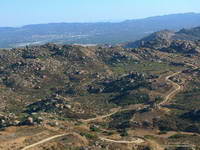
Another four miles would find me at the top of the Corridor Trail, which on tired legs might as well be the edge of the earth. This steep one mile descent is the most technical on the course and as challenging as any of the hills. I am always happy to get to the bottom. From here the finish is a little more than a half-mile away and I smiled as I heard the cheers as another runner crossed the finish line.
More than 500 runners participated in the 6th edition of the Bandit Trail Runs, competing at distances that ranged from 6K up to 50K. Many thanks to Bandit Race Committee – RD Randy Shoemaker, Sarita Shoemaker, Eric Cartier, Tommi Diaz, Mat Diaz and Josh Lewis. Each year they find a way to make an outstanding event even better!
Once again the aid station volunteers were phenomenal! Thank you Nancy Shura-Dervin and the Ultraladies, the Encino Trail Heads, Sue Apostolof, Diane Treptows, and all the volunteers! There was not an aid station where I wasn’t greeted with a smile and all the help I needed. Also many thanks to those that worked registration, parking, the finish line, timing, finish line food, photography, safety, communications, and all the other work needed to put on an event like the Bandit.
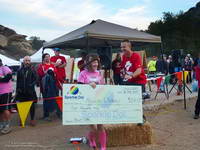
Reflecting the dedication and character of its organizers, each year the Bandit gives back by supporting an important cause. Last year Bandit raised funds for a local high school running program. This year Bandit is rallying behind runner Alison Chavez in her battle against cancer.
Here is a slideshow with a few images from this year’s 50K.
(The Bandit Trail Runs are now the Rocky Peak Trails races.)
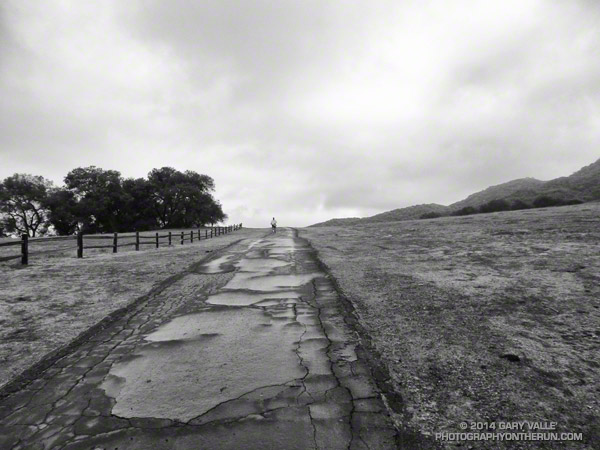
When I turned the corner at the Trippet Ranch parking lot and started up the hill toward the Musch Trail, I did a double take. The road was wet and it looked like it had been raining!
While it wasn’t impossible that a rogue shower had been spawned from the deep layer of moisture flowing over the area, it was far more likely the road was just wet from on-again, off-again drizzle.
On the way over from the end of Reseda one thing is for sure — there had been no rain. The dirt roads and trails had been in great shape. It would have been an exaggeration to describe them as damp. Although cool and cloudy, the weather was excellent for running and I’d removed my sleeves miles ago.
The Trippet Ranch Loop is a favorite. I’d taken the fire roads out from the end of Reseda, now on the way back it would be almost entirely single track trail.
Some related posts: Trippet Ranch Oaks, Trippet Ranch Mule Deer, The Heavenly Ranch in the Hills, Ferns Along the Garapito Trail, Garapito Trail Runs
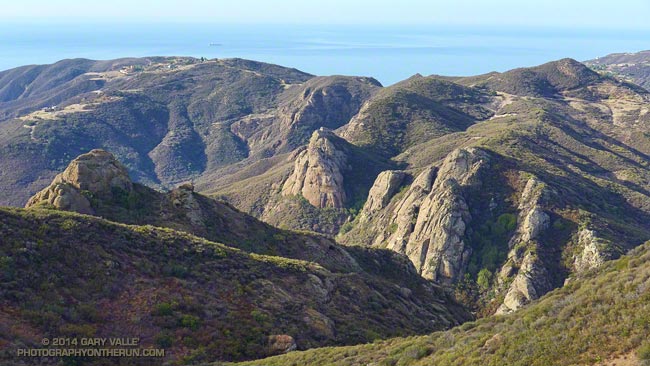
Rock Formations Along Wet Fork Arroyo Sequit from the Backbone Trail
The Coyote Backbone Trail Ultra was one of the most enjoyable runs I did last year. The low key approach with the emphasis on the experience rather than the clock was the perfect fit for my first 100K+ run. To be able to run the entire Backbone Trail with great support, company and entertainment was fantastic.
Today’s run — the second of four 2014 Backbone Ultra training runs — was from Kanan Road to the Mishe Mokwa trailhead near Circle X. This approximately 15 mile segment is one of the most scenic on the Backbone Trail with expansive views and superlative sections of single track trail. The 850′ climb from Encinal Canyon to Etz Meloy Motorway is so well-graded you (almost) don’t realize you’re gaining elevation.
I was looking to get in some extra mileage and it turned out running cohort Ann Ongena was as well. Ann was marking the course for the training run, so the plan was to do the Kanan to Mishe Mokwa segment and then continue from Mishe Mokwa another 13 miles or so to the Wendy Drive trailhead in Newbury Park.
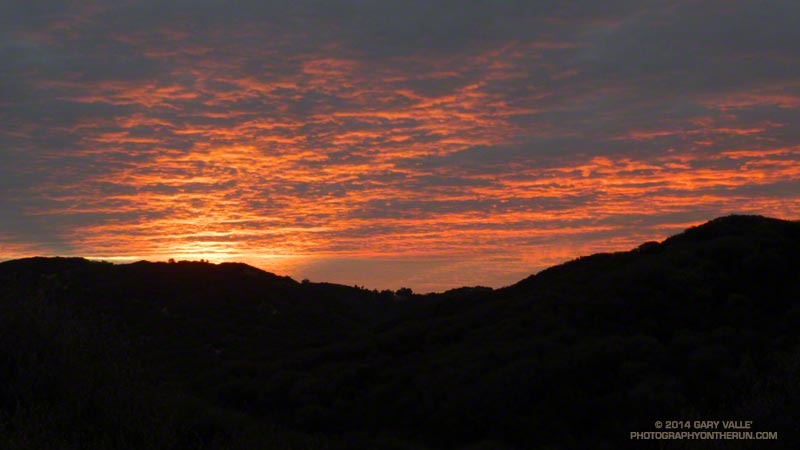
A little before dawn Backbone Ultra RD Howard Cohen dropped us off at the Kanan Road trailhead and then headed back to Mishe Mokwa to coordinate the training run. The temp at the trailhead was around 60 degrees, which is about 30 degrees warmer than last year’s frosty training run on this segment.
For some reason my GPS watch was a little slow to sync with the satellites, and while I waited Ann was already busy on the trail. Course markings don’t have to be numerous or obtrusive to be effective. The few markers she would place would be removed by Tres when he swept the course.
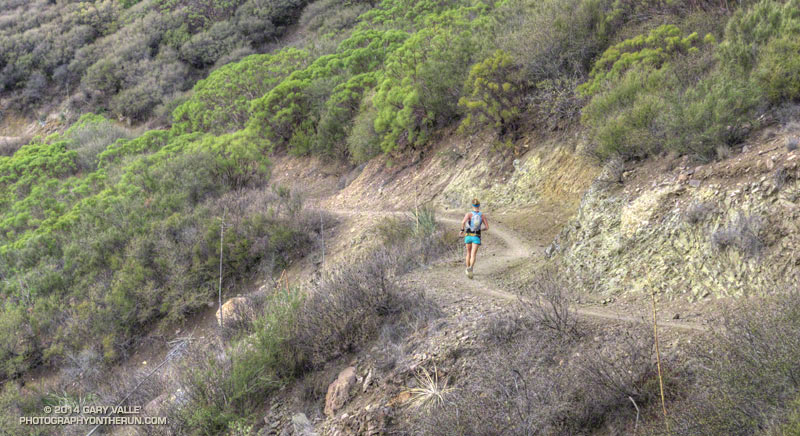
The run from Kanan to Mishe Mokwa went well. As has been the case too often this Winter, the weather was nearly ideal for running. Last year at this time Downtown Los Angeles had recorded 4.35 inches of rain for the water year (since July 1). That was well below average. This water year to date we’ve only recorded 0.97 inch of rain — a meager amount and less than in the record driest water year of 2006-2007.
On this run and all the runs I’ve been doing this Winter I’ve been looking at how the chaparral plants deal with drought. Generally, they reduce their water needs by not flowering, remaining dormant, dropping leaves, producing much smaller leaves, folding or rolling their leaves and in other ways. Some annuals simply don’t germinate. Some plants such as chamise, with its needle-like leaves, deal with drought well; others such as bush monkeyflower are barely recognizable.
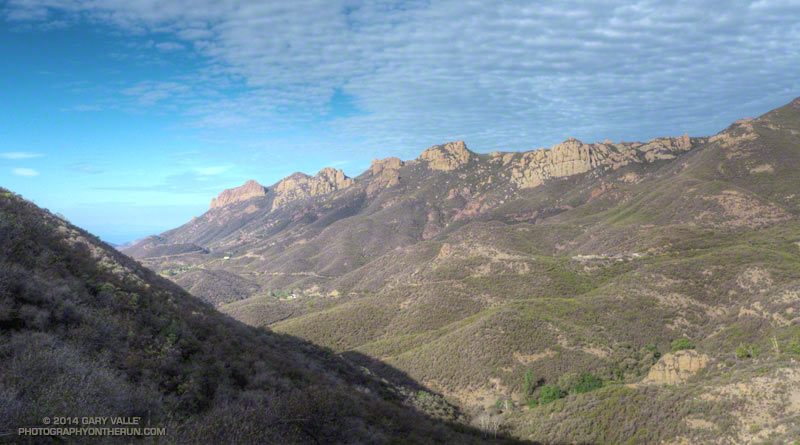
As I reached the high point of the Yerba Buena segment of the BBT above Mishe Mokwa and Circle X I vividly recalled being there during last year’s Backbone Ultra. It was about 9:30 at night and I had been running for 15 hours. I could see the lights of the aid station in the valley below and then heard — or thought I heard — cheers for a runner reaching the aid station. Although barely audible, those cheers picked up my spirits as much as they did the runner reaching the aid station!
I didn’t hear any shouts from Mishe Mokwa this morning, but the thought made me smile. Overhead the layer of clouds which had been with us most of the morning was beginning to dissipate, and the temperature was beginning to climb. Across the valley Boney Mountain’s iconic rock formations stood in relief against a mackerel sky and I stopped a couple of times to photograph the scene.
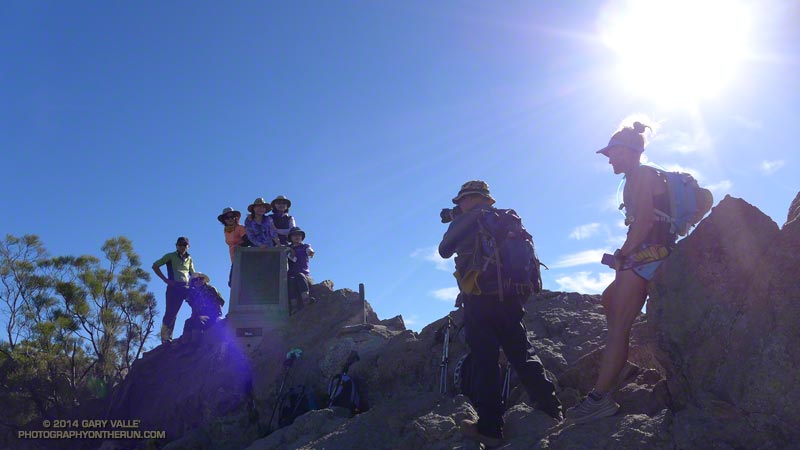
At Mishe Mokwa we enjoyed the fare at Howard’s & Victoria’s rolling aid station and relaxed for a few minutes as a large group of hikers assembled and then started up the trail.
When marking a course it’s preferable that when the main group finishes the run the course-markers be comfortably ensconced in folding lounge chairs, an IPA in hand, sweat-free and looking as they have been there for hours. With more miles to cover I substituted a soda for the IPA and after about 10 leisurely minutes we followed in the hiker’s footsteps and continued up the Backbone Trail to a busy Sandstone Peak — the highest peak in the Santa Monica Mountains.
After spending a few minutes on the summit of the popular peak we worked over to the west junction of the Tri Peaks Trail, then down the Chamberlain, Old Boney and Blue Canyon trails to Sycamore Canyon. Here we left the Backbone Trail and enjoyed a little easy running up Sycamore Canyon to the Upper Sycamore Trail. Upper Sycamore ends at Danielson Road, which we followed to Satwiwa and trails that connect to Wendy Drive.
Some related posts: Backbone Trail Training 2014 – Stunt to Kanan, Backbone Ultra – Training Run #2 (2013), Backbone Ultra 2013
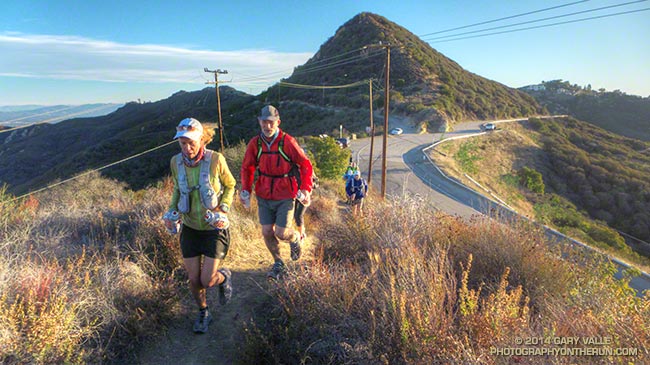
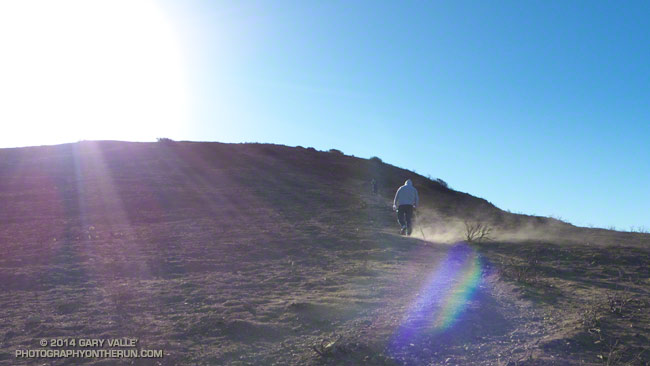
Offshore wind events have been frequent this rain season. They often follow “inside slider” systems that miss Southern California and take a more inland track over the West. The result is more wind and less rain.
Los Angeles wrapped up calendar year 2013 with the least amount of rainfall on record. When talking about rainfall in Southern California it is more common to refer to the “rain year” which runs from July 1 to June 30. (The water year was changed to October 1 to September 30,)
So when was the driest rain year in Los Angeles? It was just a few years ago, in 2006-2007 when only 3.21 inches of rain was recorded. It was also driest water year on record with only 3.73 inches of rain.
There were also many wind events in that dry rain season, and like this January not a lot of green in the hills. To date we have had less rainfall this water year than in 2006-2007!
For the most part this Fall and Winter I’ve been able to work around the wind events and do runs that more or less escaped the wind. I thought that was going to be the case again today. The predicted offshore event seemed to be behind schedule and when I left for the Wendy Drive trailhead there wasn’t much wind.
There were stirrings of an offshore breeze at the trailhead and I commented to a hiker that I hoped the winds would hold off until later in the day. The plan was to do the out and back run from Wendy Drive to Mugu Peak. Because of the myriad of route choices, this is a fun run to do as a time challenge. What is the fastest route? Try it and see.
Things looked good all the way down Sycamore Canyon and into La Jolla Valley, but the wind started to pick up as I worked toward Mugu Peak.
Once on the peak it was like flipping a switch on a wind tunnel! I was ahead of my PR to the peak by several minutes and I was trying to push the pace. That was not happening and several times I had to pause and put a hand down as I staggered in the middle of a big step.
I caught up to a couple of people just before the final steep push to the summit. The wind flow was not as turbulent and gusty here and one of them started to run. With each stride the dust streaked from his shoes. I stopped to take some photos and this short video clip. The smoother winds didn’t last for long, and neither did the running.
Mugu Peak’s next door neighbor to the west, Laguna Peak, has recorded a wind gust of 125 mph. In this photo from Boney Mountain Mugu Peak is on the far left and Laguna Peak has the communications equipment on the summit. Today I’d estimate the strongest gusts on Mugu Peak were in the range of 50-60 mph. The winds were strong enough that the sewn end of a fluttering strap was like a whip and just as capable of raising a welt.
I spent zero time on the summit and was very happy to get back down to La Jolla Valley.
Some related posts: Wendy Drive – Mugu Peak Challenge, La Jolla Valley & Mugu Peak from Wendy Drive